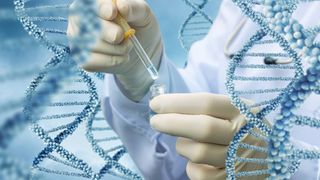Microsoft opens up new alliance to spur on data storage on DNA
DNA-based storage will help address the spiralling growth of digital data

Two biotech companies have joined Microsoft to create an alliance that hopes to create a DNA-based storage system that’s both cost effective and commercially viable.
Western Digital has also joined the partnership, with the intention of offering the new storage option to come out of the alliance, as part of its growing portfolio of offerings that look to address various storage requirements.
The four founding members of the DNA Data Storage Alliance (DDSA) and their partners are hoping to now work together to standardize and promote the adoption of a potential future DNA-based storage system.
- Here’s a list of the best data recovery services
- And here are the best cloud backup services
- Checkout our collection of the best free backup solutions
Inspired by nature
The DDSA is the result of its members’ conviction that the existing storage technology will soon be overwhelmed by the exponential growth of data. Their search for a new resilient high-capacity medium led them to DNA.
The group promotes DNA as a stable format storage medium that is durable for an incredibly long time when properly stored. It is also pretty dense and can fit 10 full length digital movies into a volume that’s the size of a single grain of salt.
Dr. Emily M. Leproust, CEO and co-founder of Twist Bioscience believes that, “DNA is an incredible molecule that, by its very nature, provides ultra-high-density storage for thousands of years.”
At the core of the alliance is the technology developed by Twist Bioscience to manufacture synthetic DNA by “writing” DNA on a silicon chip. Microsoft has successfully leveraged the system towards a working solution: “In collaboration with University of Washington, we have demonstrated a fully automated end-to-end system capable of storing and retrieving data from DNA, and we have separately stored 1GB of data in DNA synthesized by Twist and recovered data from it,” shared Dr. Karin Strauss, senior principal research manager at Microsoft.
Are you a pro? Subscribe to our newsletter
Sign up to the TechRadar Pro newsletter to get all the top news, opinion, features and guidance your business needs to succeed!
The process of storing data on DNA begins by first converting the digital data into a DNA sequence. This sequence is then encoded in segments of DNA that are 200 to 300 bases long. By using error-correcting algorithms, the new system also ensures an error-free recovery of the data.
It is reasonable to expect tangible solutions emerge from the alliance in the near future, especially in light of Gartner’s predictions that estimates that 30% of digital businesses will mandate DNA storage trials by 2024.
It’s also worth noting that besides the alliance, there are several other initiatives exploring DNA-base storage systems such as Catalog and OligoArchive.
- We’ve rounded up the best cloud storage services
With almost two decades of writing and reporting on Linux, Mayank Sharma would like everyone to think he’s TechRadar Pro’s expert on the topic. Of course, he’s just as interested in other computing topics, particularly cybersecurity, cloud, containers, and coding.

